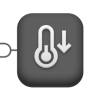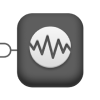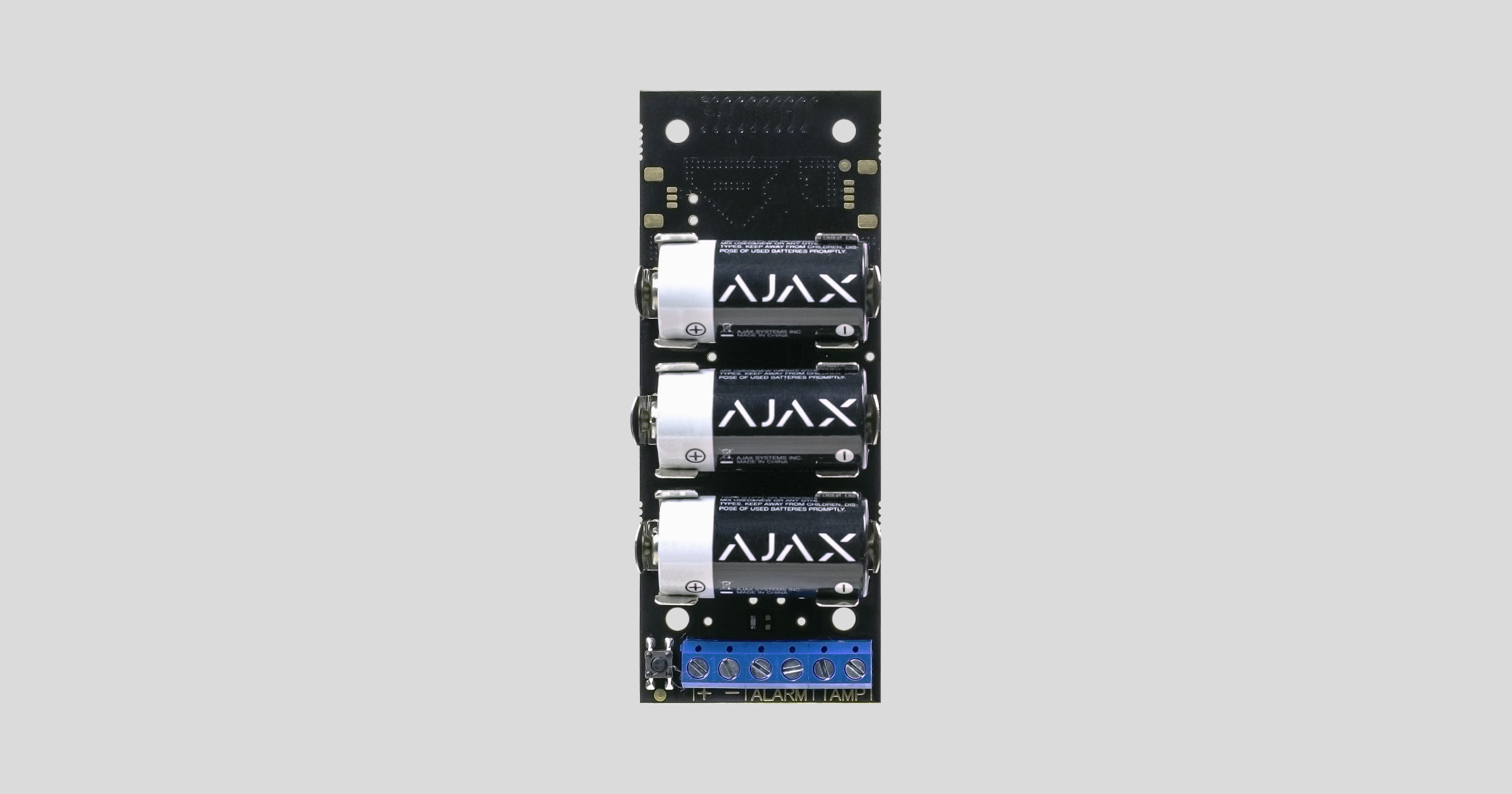Transmitter é um módulo para ligar detectores de terceiros ao sistema de segurança Ajax. Transmite alarmes e notifica quando a adulteração do detetor de terceiros é acionada. O módulo está equipado com o seu próprio acelerómetro, que o protege contra a desmontagem. Funciona com pilhas e pode fornecer energia ao detetor ligado.
O Transmitter funciona no âmbito do sistema de segurança Ajax, ligando-se através do protocolo protegido Jeweller ao hub. Não se destina a utilizar o dispositivo em sistemas de terceiros.
Não compatível com o uartBridge ou o ocBridge Plus
O alcance da comunicação pode ser de até 1.600 metros, desde que não haja obstáculos e a caixa seja removida.
O Transmitter é configurado através de uma aplicação móvel para smartphones com iOS e Android.
Elementos funcionais
- Código QR com a chave de registro do dispositivo.
- Contactos das pilhas.
- Indicador LED.
- Botão ON/OFF.
- Terminais para a alimentação eléctrica do detetor, alarme e sinais de sabotagem.
Procedimento de funcionamento
O Transmitter foi concebido para ligar sensores e dispositivos com fios de terceiros ao sistema de segurança Ajax. O módulo de integração recebe informações sobre alarmes e ativação de tamper através dos fios ligados aos grampos.
O Transmitter pode ser utilizado para ligar botões de pânico e de pedido auxiliar, detectores de movimento interiores e exteriores, bem como detectores com fios de abertura, vibração, rutura, incêndio, gás, fugas e outros.
Além disso, pode configurar a KeyArm Zone que permite alternar os modos de armação do sistema com um dispositivo de terceiros ligado ao Transmitter. KeyArm permite-lhe armar/desarmar o sistema, grupos individuais ou gerir Modo Noturno.
A funcionalidade KeyArm é suportada por todos os hubs (exceto o modelo Hub) com o OS Malevich 2.17 e superior.
O tipo de alarme é indicado nas definições do Transmitter. O texto das notificações sobre alarmes e eventos do dispositivo ligado, bem como os códigos de eventos transmitidos para o painel de monitorização central da empresa de segurança (CRA), dependem do tipo selecionado.
Tipos de eventosde dispositivos com fios
| Tipo | Ícone | Significado |
| Intrusão |
 |
Alarme quando são acionados detectores de movimento, de abertura ou outros. |
| Incêndio |
 |
Alarme quando os detectores de incêndio disparam. |
| Alarme auxiliar |
 |
Alarme ao premir o botão de pedido auxiliar. |
| Botão de pânico |
 |
Alarme ao premir o botão de pânico. |
| Alarme contra fugas de gás |
 |
Alarme quando a concentração de gás é excedida. |
| Avaria |
 |
Notificação do mau funcionamento do dispositivo ligado. O Transmitter deve ser ligado ao Hub Plus, Hub 2 (2G), Hub 2 (4G), Hub 2 Plus, Hub Hybrid (2G) ou Hub Hybrid (4G) com a versão de firmware OS Malevich 2.13.0 ou superior. |
| Fugas |
 |
Alarme quando os detectores de fugas de água disparam. |
| Quebra de vidro |
 |
Alarme quando o sensor de quebra de vidro é acionado. Este tipo de evento só funciona no modo de funcionamento Impulso. |
| Temperatura elevada |
 |
Alarme quando o limite superior de temperatura é excedido. |
| Temperatura baixa |
 |
Alarme quando o limite inferior de temperatura é excedido. |
| Mascaramento |
 |
Alarme quando mascaramento do dispositivo é detetado. |
| Código de coação (abertura) |
 |
Alarme quando o código de coação é introduzido. Este tipo de evento só funciona no modo de funcionamento Impulso. |
| Vibração (sensor sísmico) |
 |
Alarme quando o sensor sísmico é acionado. Este tipo de evento só funciona no modo de funcionamento Impulso. |
| Personalizado |
 |
O tipo de evento que é configurado pelo utilizador. Não é enviado para a estação de controlo da empresa de segurança. O Transmitter deve ser ligado ao Hub Plus, Hub 2 (2G), Hub 2 (4G), Hub 2 Plus, Hub Hybrid (2G) ou Hub Hybrid (4G) com a versão de firmware OS Malevich 2.13.0 ou superior. |
O Transmitter tem 2 pares de zonas com fios: alarme e tamper.
Um par de terminais separado assegura a alimentação do detetor externo a partir das baterias do módulo com 3,3 V.
Conexão ao hub
O hub e o dispositivo que operam em diferentes radiofrequências são incompatíveis. A gama de radiofrequências do dispositivo pode variar consoante a região. Recomendamos comprar e utilizar dispositivos Ajax na mesma região. Pode verificar a gama de radiofrequências de funcionamento com o serviço de suporte técnico.
Antes de iniciar a ligação
- Seguindo as recomendações das instruções do hub, instale a aplicação Ajax no seu smartphone. Crie uma conta, adicione o hub à app e crie pelo menos uma sala.
- Vá para a app Ajax.
- Ligue o hub e verifique a ligação à Internet (via cabo Ethernet e/ou rede GSM).
- Certifique-se de que o hub está desarmado e não inicia a atualização, verificando o seu estado na app Ajax.
Apenas os utilizadores com direitos de administrador podem adicionar o dispositivo ao hub.
Como ligar o Transmitter ao hub
- Selecione a opção Adicionar dispositivo na aplicação Ajax.
- Dê um nome ao dispositivo, digitalize ou introduza manualmente o código QR (localizado no corpo e na embalagem) e selecione a sala de localização.
- Clique em Adicionar — a contagem decrescente começará.
- Ligue o dispositivo (premindo o botão ligar/desligar durante 3 segundos).
Para que a deteção e a interface ocorram, o dispositivo deve estar localizado dentro da área de cobertura da rede sem fios do hub (num único objeto protegido).
O pedido de conexão ao hub é enviado por um curto período de tempo assim que o dispositivo é ligado.
Se a ligação ao hub Ajax falhar, o Transmitter desliga-se após 6 segundos. Pode então repetir a tentativa de conexão.
O Transmitter ligado ao hub aparecerá na lista de dispositivos do hub na aplicação. A atualização do estado do dispositivo na lista depende do tempo de consulta do dispositivo definido nas definições do concentrador, com o valor predefinido – 36 segundos.
Ícones
Os ícones apresentam alguns dos estados do Transmitter Jeweller. Para aceder aos mesmos:
- Inicie sessão na app Ajax.
- Selecione e espaço.
- Aceda ao separador Dispositivos
.
| Ícone | Significado |
|
Força do sinal do Jeweller – apresenta a força do sinal entre o hub e o módulo de integração. O valor recomendado é de 2–3 barras. |
|
|
Nível de carga da bateria do módulo de integração. |
|
| O módulo de integração funciona através de um extensor de alcance do sinal de rádio. | |
|
O dispositivo está no modo de teste de atenuação do sinal. |
|
|
O Transmitter Jeweller está permanentemente desativado. |
|
|
O Transmitter Jeweller está desativado até o sistema ser desarmado pela primeira vez. |
|
| O dispositivo perdeu a ligação com o hub ou o hub perdeu a ligação com o servidor Ajax Cloud. | |
|
O dispositivo não foi transferido para o novo hub. |
|
| O sensor funciona no modo de Mudança dos modos de segurança. | |
| Ícones de modos e tipos de eventos quando o sensor funciona no modo Detetar alarmes | |
|
A função Chime está ativada. |
|
|
Atraso à entrada e/ou saída está ativado. |
|
|
O dispositivo funciona no modo Sempre ativo. |
|
|
O dispositivo funcionará quando Modo Noturno estiver ativado. |
|
| O tipo de evento Intrusão está selecionado. | |
| Alarme de intrusão. | |
|
O detetor tem os eventos de disparo de sabotagem permanentemente desactivados. |
|
|
O Transmitter Jeweller tem os eventos de ativação de tamper desactivados durante o tempo em que o modo armado está ativo. |
|
| O tipo de evento Fogo está selecionado. | |
| O dispositivo detetou um alarme de incêndio. | |
| O tipo de evento Alarme auxiliar está selecionado. | |
| Alarme quando o botão auxiliar é pressionado. | |
| Tipo de evento O botão Pânico está selecionado. | |
| Alarme quando o botão de pânico é premido. | |
| O tipo de evento Alarme de gás está selecionado. | |
| Alarme quando a concentração de gás é excedida. | |
| O tipo de evento Avariação é selecionado. | |
| Foi detetada uma avaria no dispositivo. | |
| O tipo de evento Fuga é selecionado. | |
| Alarme causado pela inundação. | |
| O tipo de evento Personalizado está selecionado. | |
| O dispositivo foi acionado. | |
| O tipo de evento Quebra de vidro está selecionado. | |
| Alarme de quebra de vidro. | |
| O tipo de evento Temperatura elevada está selecionado. | |
| Alarme quando o limite superior de temperatura é excedido. | |
| O tipo de evento Temperatura baixa está selecionado. | |
| Alarme quando o limite inferior de temperatura é excedido. | |
| O tipo de evento Mascaramento está selecionado. | |
| Alarme de máscara. | |
| O tipo de evento Código de coação (abertura) está selecionado. | |
| Alarme causado pelo desarme do sistema utilizando o dispositivo de código de coação. | |
| O tipo de evento Vibração (sensor sísmico) está selecionado. | |
| Alarme de vibração (sísmico). | |
Estados
O ecrã de estados contém informações sobre o dispositivo e os seus parâmetros atuais. Os estados do Transmitter e do dispositivo a ele ligado podem ser consultados na aplicação Ajax:
- Aceda ao separador Dispositivos
.
- Selecione Transmitter na lista.
| Parâmetro | Significado |
| Importação de dados | Apresenta o erro aquando da transferência de dados para o novo hub:
|
| Temperatura |
Temperatura do detetor. Medido no processador e muda gradualmente. Erro aceitável entre o valor na app e a temperatura ambiente — 2°C. O valor é atualizado assim que o detetor identifica uma variação de temperatura de, pelo menos, 2°C. É possível configurar um cenário por temperatura para controlar dispositivos de automatização. |
| Intensidade de sinal Jeweller |
Força do sinal entre o hub/extensor de alcance e o Transmitter. Recomendamos a instalação do detetor em locais onde a intensidade do sinal é de 2-3 barras. |
| Ligação através de Jeweller | Estado da ligação entre o hub/extensor de gama e o dispositivo:
|
| Potência do Transmitter |
Apresenta a potência selecionada do Transmitter. O parâmetro aparece quando a opção Máx ou Atenuação é selecionada no menu Teste de atenuação do sinal. |
| Nome do repetidor ReX | Indica se o Transmitter está ligado através de um extensor do alcance do sinal de rádio. |
| Carga da bateria |
Nível da bateria do dispositivo. Apresentado como uma percentagem. |
| Tampa | Estado da zona de sabotagem do dispositivo. |
|
Estado do sensor externo (apresentado apenas quando o detetor está no modo biestável) |
Apresenta o estado da zona de alarme do detetor ligado. Estão disponíveis dois estados:
|
| Alertar se for movido | Liga o acelerómetro incorporado, detectando o movimento do dispositivo. |
| Sempre ativo |
Quando esta opção está activada, o módulo de integração está constantemente armado e notifica os alarmes dos detectores ligados. |
| Ativação da campainha |
Quando a função está activada, as sirenes ligadas ao sistema notificam o disparo dos detectores de abertura integrados com a ajuda do Transmitter, enquanto o sistema está desarmado. |
| Desativação permanente | Mostra o estado da função de desativação permanente do dispositivo:
|
| Reações a Alarmes | |
| Modo de funcionamento | Mostra como o detetor reage aos alarmes:
|
| Atraso ao Entrar, s |
O atraso de entrada (atraso de ativação do alarme) é o tempo que tem para desarmar o sistema de segurança depois de entrar na sala. |
| Atraso à saída, s |
Tempo de atraso na saída. Atraso de saída (atraso de ativação do alarme) é o tempo que tem para sair da sala depois de armar o sistema de segurança. |
| Modo noturno Atraso ao entrar, s |
O tempo de atraso ao entrar no modo noturno. O atraso ao entrar (atraso de ativação do alarme) é o tempo que tem para desarmar o sistema de segurança depois de entrar nas instalações. |
| Modo noturno Atraso à saída, s |
O tempo de atraso à saída no Modo Noturno. Atraso de saída (atraso de ativação do alarme) é o tempo que tem para sair das instalações depois de o sistema de segurança estar armado. |
| Firmware | Versão do firmware do detetor. |
| ID do dispositivo | Identificador do dispositivo. |
| Número do Dispositivo | Número do bucle do aparelho (zona). |
Definições
Para alterar as definições do Transmitter na aplicação Ajax:
- Aceda ao separador Dispositivos
.
- Selecione Transmitter na lista.
- Aceda a Definições clicando no ícone de engrenagem
.
- Defina os parâmetros necessários.
- Clique em Voltar para salvar as novas configurações.
| Definição | Significado |
| Nome |
Nome do detetor que pode ser alterado. O nome é apresentado no texto das mensagens SMS e das notificações no historial de eventos. O nome pode conter até 12 caracteres cirílicos ou até 24 caracteres latinos. |
| Sala | Seleção da sala virtual à qual o Transmitter está atribuído. O nome da sala é apresentado no texto de SMS e notificações no historial de eventos. |
| Fonte de Alimentação para Detetores Ligados | Alimentação de 3,3 V para um detetor com fios de terceiros:
Se o modo Sempre Ativo estiver ativado, a fonte de alimentação do detetor de terceiros está ligada no modo Sempre Ativo ou Desativado se estiver desarmado, independentemente do estado do sistema de segurança. |
| Estado do contacto do detetor externo | Seleção do estado normal do detetor externo:
|
| Tipo de detetor externo | Seleção do tipo de detetor externo:
|
| Modo do Sensor | Seleção do modo de sensor do dispositivo ligado:
|
| Tipos de eventos |
Seleção de um tipo de evento para o detetor ou dispositivo ligado. Consulte a secção Tipos de eventos de dispositivos com fios para obter mais informações. Os textos das notificações no feed de eventos e SMS, bem como o código transmitido à estação de monitorização da empresa de segurança, dependem do tipo de evento selecionado. Esta definição está disponível se a opção Notificar Alarmes estiver selecionada para a definição Modo do Sensor. |
| Definições do interrutor para armar | Configuração da alternação de modos de armamento se a opção Alternar Modos de Armamento estiver selecionada para a configuração do Modo do Sensor:
Ativar a funcionalidade Notificar tentativas de utilização do interrutor de armar quando está bloqueado para receber notificações por cada tentativa de mudar o modo de armar com um interrutor de armar bloqueado. Quando bloqueada, não pode alternar de modo. |
| Estado de violação | Seleção do modo de sabotagem normal para um detetor externo:
|
| Alertar se Houver Movimento | Ativar o acelerómetro incorporado para receber um alarme em caso de movimento do dispositivo. |
| Sempre ativo |
Quando esta opção está activada, o módulo de integração está constantemente armado e notifica os alarmes dos detectores ligados. Esta definição está disponível se a opção Notificar Alarmes estiver selecionada para a definição Modo do Sensor. |
| Alerta com uma sirene se for detetado um alarme | Se estiver ativado, os sirens adicionados ao sistema são activados se for detectado um alarme. |
| Alerta com uma sirene se o acelerómetro for acionado | Se ativado, os sirens adicionados ao sistema são acionados se o movimento do dispositivo for detectado. |
| Definições de Chime |
Abre as definições do Chime. |
| Reações a Alarmes | |
| Modo de funcionamento | Especifique como este dispositivo irá reagir aos alarmes:
|
| Atraso ao Entrar, s |
Seleção do tempo de atraso para entrar. O atraso ao entrar (atraso de ativação do alarme) é o tempo que tem para desarmar o sistema de segurança depois de entrar na sala. |
| Atraso à saída, s |
Seleção do tempo de atraso ao sair. Atraso de saída (atraso de ativação do alarme) é o tempo que tem para sair da sala depois de armar o sistema de segurança. |
| Armar no Modo Noturno | Se estiver ativado, o detetor ligado ao módulo de integração passará para o modo armado quando utilizar o modo noturno. |
| Modo noturno Atraso ao entrar, s |
O tempo de Atraso à entrada no Modo Noturno. O atraso ao entrar (atraso de ativação do alarme) é o tempo que tem para desarmar o sistema de segurança depois de entrar nas instalações. |
| Modo noturno Atraso à saída, s |
O tempo de Atraso ao sair no modo noturno. Atraso de saída (atraso de ativação do alarme) é o tempo que tem para sair das instalações depois de o sistema de segurança estar armado. |
| Teste de Intensidade de Sinal de Jeweller |
Passa o Transmitter para o modo de teste da intensidade do sinal do Jeweller. |
| Teste de atenuação do sinal |
Passa o Transmitter para o modo de teste de atenuação do sinal (disponível no dispositivo com firmware versão 3.50 e posterior). |
| Guia do Utilizador | Abre o Manual do Utilizador do Transmitter na aplicação Ajax. |
| Desativação permanente | Estão disponíveis três opções:
Saiba mais sobre a desativação permanente de dispositivos O sistema também pode desativar automaticamente os dispositivos quando o número definido de alarmes é ultrapassado ou quando o temporizador de recuperação expirar. |
| Desativação Única |
Permite ao utilizador desativar eventos do dispositivo até ao primeiro evento de desarme do sistema. Estão disponíveis três opções:
|
| Desemparelhar Dispositivo | Desliga o dispositivo do hub e elimina as suas definições. |
Como definir o Chime
O Chime é um sinal sonoro que indica o acionamento dos detetores de abertura quando o sistema é desarmado. A funcionalidade é utilizada, por exemplo, em lojas, para notificar os funcionários de que alguém entrou no edifício.
As notificações são configuradas em duas fases: configuração dos detetores de abertura e configuração das sirenes.
Definições do Transmitter
Antes de configurar a funcionalidade Chime, certifique-se de que um detetor de abertura com fios está ligado ao Transmitter e que as seguintes opções foram configuradas nas definições do detetor na aplicação Ajax:
- Fonte de alimentação do detetor
- Estado do contacto do detetor externo
- Tipo de detetor externo
- Tipos de eventos
- Estado de violação
- Aceda ao menu Dispositivos
.
- Selecione Transmitter.
- Aceda às suas definições clicando no ícone da engrenagem
no canto superior direito.
- Aceda ao menu Configurações de toque.
- Selecione a notificação da sirene para o evento Se o contacto externo estiver aberto.
- Selecionar o som da campainha: 1 a 4 bips. Uma vez selecionado, a app Ajax reproduzirá o som.
- Clique Voltar duas vezes para guardar as definições.
- Configure a sirene necessária.
Indicação
| De mascaramento | Indicação |
| O módulo está ligado e registado | O LED acende-se quando o botão ON é premido por breves instantes. |
| O registo falhou | O LED pisca durante 4 segundos com um intervalo de 1 segundo, depois pisca 3 vezes rapidamente (e desliga-se automaticamente). |
| O módulo é eliminado da lista de dispositivos de hub | O LED pisca durante 1 minuto com um intervalo de 1 segundo, depois pisca 3 vezes rapidamente (e desliga-se automaticamente). |
| O módulo recebeu um sinal de alarme/violação | O LED acende-se durante 1 segundo. |
| As baterias estão descarregadas | Acende-se e apaga-se suavemente quando o detetor ou a sabotagem é activada. |
Teste de desempenho
Um sistema de segurança Ajax permite efetuar testes para verificar a funcionalidade dos dispositivos ligados.
Os testes não se iniciam de imediato, mas num período de 36 segundos quando se utilizam as definições padrão. O início do tempo de teste depende das configurações do período de varredura do detetor (o parágrafo sobre configurações Jeweller nas configurações do hub).
Ligação do módulo ao detetor com fios
A localização do Transmitter determina a sua distância em relação ao hub e a presença de obstáculos entre os dispositivos que impedem a transmissão do sinal de rádio: paredes, pisos inseridos, objectos de grandes dimensões localizados na sala.
Verificar o nível de intensidade do sinal no local de instalação.
Se o nível do sinal for de uma divisão, não podemos garantir o funcionamento estável do sistema de segurança. Tome as medidas possíveis para melhorar a qualidade do sinal. Pelo menos, mova o dispositivo com um módulo de integração – mesmo uma deslocação de 20 cm pode melhorar significativamente a intensidade do sinal.
Se, após a deslocação, o dispositivo continuar a ter uma intensidade de sinal baixa ou instável, utilize um extensor de alcance do sinal de rádio.
O Transmitter deve ser instalado no interior da caixa do detetor com fios. O módulo requer um espaço com as seguintes dimensões mínimas: 110 × 41 × 24 mm. Se a instalação do Transmitter na caixa do detetor for impossível, pode ser utilizada qualquer caixa radiotransparente disponível.
- Ligar o Transmitter ao detetor através dos contactos NC/NO (escolher a definição relevante na aplicação) e COM.
O comprimento máximo do cabo para a ligação do sensor é de 130 m (par entrançado 24 AWG). O valor pode variar quando se utiliza um tipo de cabo diferente.
A função dos terminais do Transmittera
- “+ -“ – terminais de alimentação do dispositivo com fio conectado, a tensão de saída é de 3,3 V⎓.
- ALARME – terminais de alarme do dispositivo.
- TAMP – terminais do dispositivo inviolável
Não ligue uma fonte de alimentação de terceiros aos terminais de alimentação. Isto pode danificar o dispositivo.
-
Fixe o Transmitter na caixa. As barras de plástico estão incluídas no kit de instalação. Recomenda-se a instalação do Transmitter nos mesmos.
Não instalar o Transmitter:
- Perto de objetos metálicos e espelhos (podem proteger o sinal de rádio e provocar a sua atenuação).
- Mais perto do que 1 metro de um hub.
Manutenção e Substituição da Bateria
O dispositivo não necessita de manutenção quando montado na caixa de um sensor com fios.
Características técnicas
Conjunto completo
- Transmitter.
- Bateria CR123A – 3 peças.
- Kit de instalação.
- Guia rápido.
Garantia
A garantia dos produtos da empresa de responsabilidade limitada “Ajax Systems Manufacturing” é válida por 2 anos após a compra e não se aplica à bateria pré-instalada.
Caso o dispositivo não funcione corretamente, deverá contactar, em primeiro lugar, o serviço de apoio — em metade das vezes, os problemas técnicos podem ser resolvidos remotamente!
Contactar o Suporte Técnico:




